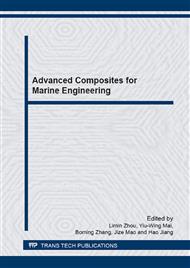[1]
AG Gibson, JM Linden, D Elder and KH Leong. Non-metallic pipe systems for oil and gas: A review. Plastic Rubber and Composites 2011; 40 (10).
DOI: 10.1179/1743289811y.0000000006
Google Scholar
[2]
OO Ochoa. Composite Riser Experience and Design Guidance: Final Project Report prepared for mineral management service. MMS Project Number 490, (2006).
Google Scholar
[3]
Tsai, Stephen W., Theory of Composites Design, Think Composites, Dayton, (1992).
Google Scholar
[4]
G. Ramirez MD. Engelhardt., Experimental investigation of a large-scale composite riser tube under external pressure. Journal of pressure vessel technology. Volume: 131 Issue: 5 Article number: 051205.
DOI: 10.1115/1.3122773
Google Scholar
[5]
Mohammad Z. Kabir, Finite element analysis of composite pressure vessels with a load sharing metallic liner, Composite Structures 49 (2000) 247-255.
DOI: 10.1016/s0263-8223(99)00044-6
Google Scholar
[6]
YM Tarnopolskii, AI Beyle and VL Kulakov. Composite Risers for Offshore Technology: Institute of Polymer Mechanics of Latvian University, Riga LV-1006, Latvia.
Google Scholar
[7]
DD Baldwin, NL Newhouse, KH Lo and RC Burden. Composite Production Riser Design, in Offshore Technology Conference, OTC 8431, May 5-8, 1997, Houston, TX.
DOI: 10.4043/8431-ms
Google Scholar
[8]
MD Drey, MM Salama, JR Long, MG Abdallah and SS Wang. Composite Production Riser - Testing and Qualification, in Offshore Technology Conference, OTC 8432, May 5-8, 1997, Houston, TX.
DOI: 10.4043/8432-ms
Google Scholar
[9]
DD Baldwin, KH Lo and JR Long. Design Verification of a Composite Production Riser, in Offshore Technology Conference, OTC 8664, May 4-7, 1998, Houston, TX.
Google Scholar
[10]
DB Johnson, MM Salama, JR Long, and SS Wang. Composite Production Riser - Manufacturing Development and Qualification Testing, " in Offshore Technology Conference, OTC 8665, May 4-7, 1998, Houston, TX.
DOI: 10.4043/8665-ms
Google Scholar
[11]
G. Hu, Jinbo Bai, Ekaterina Demianouchko, Philippe Bombard, Mechanical Behavior of ±55° Filament wound Glass Fibre, Epoxy Resin Tubes: III. Macromechanical model of the macroscopic behavior of tubular structures with damage and failure envelope prediction, Composites Science and Technology 58 (1998).
DOI: 10.1016/s0266-3538(97)00078-x
Google Scholar
[12]
J. Rousseau, D. Perreux, N. Verdiere, The Influence of Winding Patterns on the damage behavior of Filament Wound Pipes, Composites Science and Technology 59 (1999), pp.1439-1449.
DOI: 10.1016/s0266-3538(98)00184-5
Google Scholar
[13]
D. Cohen, Influence of filament winding parameters on composite vessel quality and strength Composites Part A 28A (1997) 1035-1037.
DOI: 10.1016/s1359-835x(97)00073-0
Google Scholar
[14]
Y. D. Doh, C. S. Hong, Progressive Failure Analysis for Filament Wound Pressure Vessel. Journal of Reinforced Plastics and Composites December 1995 vol. 14, pp.1278-1306.
DOI: 10.1177/073168449501401203
Google Scholar
[15]
C. Wang, K. Shankar, and E.V. Morozov, Design of Composite Risers for Minimum Weight, World Academy of Science, Engineering and Technology 72 (2012).
Google Scholar


